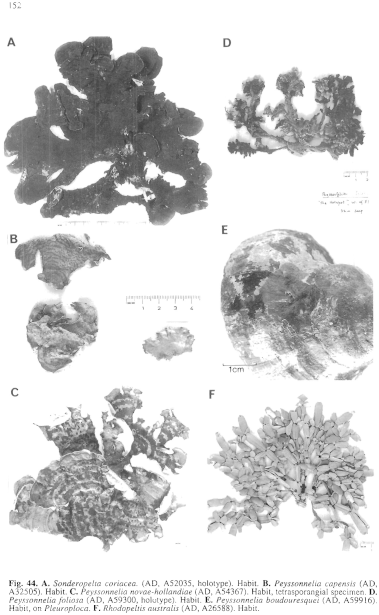|
|
|
|
|
|||||||||||
|
Electronic Flora of South Australia Species Fact Sheet
Phylum Rhodophyta – Class Florideophyceae – Order Gigartinales – Family Peyssonneliaceae
Thallus (Fig. 44D) dark brown-red, 2–5 cm long, with a basal, usually branched, stipe 1–3 cm long and 2–4 mm in diameter, arising from a conical, densely rhizoidal, holdfast 3–5 mm across; epilithic. Fronds much branched more or less complanately, with irregular branches 3–7 mm broad, often terminally flabellate, 160–200 (–240) µm thick, lying free from the substrate but more or less horizontal. Structure (Fig. 46A). Basal layer of radiating lines of cells, each cell 12–20 µm in diameter and LID 2–5, producing from their lower side multicellular rhizoids (often branched) with dome shaped, hypobasal cells (Fig. 46A) lying within the thallus sheath, then with cylindrical cells more or less at right angles to the basal layer cells; hypobasal calcification absent or very slight. Erect filaments (Fig. 46A) assurgent at 30–40°, attached to the distal end of the basal layer cells, 8–12 µm in diameter and L/D 4–6 below, branching mainly from the lower 1–3 cells, erect above and 6–10 µm in diameter with cells isodiametric to L/D 0.5; fusiform cystoliths (Fig. 46A) present in individual cells of the lower erect filaments, mostly 80–120 µm long and 16–25 µm in diameter; rhodoplasts ovoid to elongate, tending to form a reticulum in lower cells.
Reproduction: Sexual plants with low, inconspicuous nemathecia, with slender paraphyses 120–200 µm and 8–12 cells long; carposporophytes (Fig. 46B) numerous within the nemathecia, simple or branched, with rows of ovoid to subspherical carposporangia 8–14 µm in diameter.
Tetrasporangial nemathecia inconspicuous, low, dark red, 0.2–1 mm across, scattered; paraphyses 80–100 µm and 5–8 cells long; tetrasporangia (Fig. 46A) 30–50 µm long and 10–18 µm in diameter, decussately cruciately divided.
Type from The Hotspot", W of Flinders I., S.Aust., 32 m deep (Branden, 21.vi.1988); holotype in AD, A59300.
Selected specimens: The type. Ward I., S. Aust., 20 m deep (Graske, 22.vi.1988; AD, A59250). Topgallant I., S. Aust., 6–13 m deep (Rowland, 5.iv.1988; AD, A58662). Pearson I., S. Aust., 20–25 m deep (Shepherd, 7.i.1969; AD, A33629); 22 m deep (Shepherd, 10.i.1969; AD, A34004); 30 m deep (Shepherd, 10.i.1969; AD, A34050); 36 m deep (Shepherd, 10.i.1969; AD, A34115); 30–35 m deep (Shepherd, 7.i.1969; AD, A34146); and 20–23 m deep (Shepherd & Turner, 29.iii.1982; AD, A53048). Off DeMole R., N coast Kangaroo I., S. Aust., 9–11 m deep (Mitchell, 18.ii.1960; AD, A24047).
Distribution: Islands off the west coast of Eyre Peninsula, S. Aust., in deep water; off De Mole R., Kangaroo I., S. Aust.
Taxonomic notes: P. foliosa is a distinctive species known only from deep water around islands off the west coast of Eyre Peninsula and one locality off the N coast of Kangaroo I. It was recorded as P. novae-hollandiae in Shepherd & Womersley (1971, pp. 161, 165).
P. foliosa is characterised by its habit, presence of hypothallial rhizoidal cells, and the shape and position of the cystoliths. It is superficially similar to P. replicata Kützing 1849: 694; 1869: 32, pl. 89a-c; Denizot 1968: 136, figs 35–38, from South Africa but the latter has the lower cell of erect filaments pit-connected centrally to each hypobasal cell and it also lacks cystoliths. The only other species with single, not clustered, cystoliths appears to be P. rubra (Greville) J. Agardh from the Mediterranean, but this species differs in habit and structure.
References:
DENIZOT, M. (1968). Les Algues Floridées encroûtantes (a l'exclusion des Corallinacées). (Paris.)
KÜTZING, F.T. (1849). Species Algarum. (Leipzig.)
SHEPHERD, S.A. & WOMERSLEY, H.B.S. (1971). Pearson Island Expedition 1969.-7. The subtidal ecology of benthic algae. Trans. R. Soc. S. Aust. 95, 155–167.
The Marine Benthic Flora of Southern Australia Part IIIA complete list of references.
Publication:
Womersley, H.B.S. (14 January, 1994)
The Marine Benthic Flora of Southern Australia
Rhodophyta. Part IIIA, Bangiophyceae and Florideophyceae (to Gigartinales)
Reproduced with permission from The Marine Benthic Flora of Southern Australia Part IIIA 1994, by H.B.S. Womersley. Australian Biological Resources Study, Canberra. Copyright Commonwealth of Australia.
Illustrations in Womersley Part IIIA, 1994: FIGS 44D, 46A, B.

Figure 44 enlarge
Fig. 44. A. Sonderopelta coriacea. (AD, A52035, holotype). Habit. B. Peyssonnelia capensis (AD, A32505). Habit. C. Peyssonnelia novae-hollandiae (AD, A54367). Habit, tetrasporangial specimen. D. Peyssonnelia foliosa (AD, A59300, holotype). Habit. E. Peyssonnelia boudouresquei (AD, A59916). Habit, on Pleuroploca. F. Rhodopeltis australis (AD, A26588). Habit.

Figure 46 enlarge
Fig. 46. A, B. Peyssonnelia foliosa (A, AD, A59300; B, AD, A58662). A. RVS of thallus with two cystoliths, rhodoplasts shown in one basal cell, and tetrasporangia. B. Section of a female nemathecium, with rows of carposporangia from 3 carposporophytes (two carposporangia stippled to show rhodoplasts). C–I. Peyssonnelia splendens (C, D, G, AD, A60021; E, F, H, I, AD, A57377). C. Section of thallus showing regions of clustered cystoliths and patches of hypobasal calcification. D. Detailed sectional view of clustered cystoliths. E. RVS of growing apex of thallus. F. RVS of mature thallus. G. Branching pattern of basal layer. H. Diagrammatic view of RVS with tetrasporangial nemathecium. I. Tetrasporangia and paraphyses.

|
Email Contact: State Herbarium of South Australia |

|